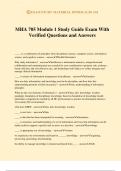©EXAM STUDY MATERIAL 8/9/2024 11:50 AM
MHA 705 Module 1 Study Guide Exam With
Verified Questions and Answers
_____ is a combination of principles from disciplinary science, computer science, information
science, and cognitive science. - answer✔✔Health Informatics
Why study informatics? - answer✔✔healthcare is information intensive, interprofessional
collaboration and communication are essential for care coordination to promote safe, evidence-
based, efficient, and cost effective care, and technology tools help us to collect integrate and
manage clinical information
____ is science of information management in healthcare. - answer✔✔informatics
How are data, information, and knowledge used in the discipline, and how does this
understanding promote wisdom in practice? - answer✔✔basic understanding of informatics
principles
What are the core elements of informatics? - answer✔✔data, info, knowledge, wisdom
paradigm, foundation of disciplinary knowledge, based on foundation of knowledge model,
informatics competencies needed by all HC professionals to practice in information intensive
21st century HC environments
what does DIKW - answer✔✔data, info, knowledge, wisdom
____ is raw facts. - answer✔✔data
____ is data that has been interpreted for meaning. - answer✔✔information
____ is awareness and understanding of a set of information and ways that information can be
made useful to support a specific task or arrive at a decision. - answer✔✔knowledge
____ is appropriate use of knowledge. - answer✔✔wisdom
we experience our environment and learn by ______ knowledge. - answer✔✔acquiring,
processing, generating, disseminating
the ability to manage knowledge is learned and honed from ___. - answer✔✔birth
, ©EXAM STUDY MATERIAL 8/9/2024 11:50 AM
the ______ is organizing conceptual framework for text, helps to explain ties between
disciplinary science, informatics, and knowledge, informatics is viewed as tool for finding
knowledge. - answer✔✔foundation of knowledge model
KA stands for ___> - answer✔✔knowledge acquisition
KD stands for _____> - answer✔✔knowledge dissemination
KG stands for _____> - answer✔✔knowledge generation
KP stands for _____> - answer✔✔knowledge processing
As technology and research continue to advance, new SDLC models are pioneered and
introduced to ____. The interpretation and implementation of any model selected reflects
knowledge and skill of team applying model. - answer✔✔enhance techniques
At times during SDLC, new into affects the ____ from earlier phases and development effort
may be re-examined or halted until these modifications can be reconciled with current design and
scope of project. - answer✔✔outputs
____ is the ability to share information across organization; this will remain paramount under
HITECH Act; ability to share patient data is extremely important, both within organization and
across organizational boundaries. - answer✔✔interoperability
____ any programmer can implement, modify, and apply, reconstruct, and restructure rich
libraries of source codes available from proven, well-tested products. - answer✔✔open source
software (OSS) and free/OSS
_____ automates many of the tasks required in systems development effort, encourage adherence
to SDLC, thus instilling high degree of rigor and standardization to entire systems development
process, these tools help to reduce cost and development time while enriching quality of product.
- answer✔✔computer aided software engineering tools (CASE)
what are the three phases of DSDM - answer✔✔pre-project, project life cycle, post projec
___ is highly iterative and incremental approach with high level of user input and involvement,
iterative process requires repetitive examination that enhances details and improves accuracy -
answer✔✔dynamic system development method DSDM
____ makes effort to represent real world objects -- modeling real world entities or things
(hospital, patient, account, respiratory therapist) into abstract computer software objects, once
system is object oriented all interactions or exchanges take place between or among objects. -
answer✔✔object oriented modeling




